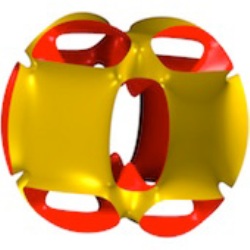The Austrian Science Fund is currently working on a project that focuses on the efficiency and motion safety of robots. The research work involves the use of mathematical equations for improving the control of the robot’s movements.
 Not a Halloween decoration but a graphic representation of an algebraic equation that allows the calculation of spaces in which a robot cannot be controlled due to geometric reasons. Credit: Josef Schadlbauer und Manfred Husty
Not a Halloween decoration but a graphic representation of an algebraic equation that allows the calculation of spaces in which a robot cannot be controlled due to geometric reasons. Credit: Josef Schadlbauer und Manfred Husty
The team is working on situations where collisions are likely to occur and on devising an optimal path of motion. The areas the research work touches upon are algebraic equations, computer-aided design and motion planning. The motor skills of the robot are programmed and the programmed code is fed into the microprocessors memory. However efficient the motion programming may be the robot is likely to falter in real life environments. The research team led by Professor Manfred Husty and Professor Hans-Peter Schröcker, is working on innovative approaches towards programming for more efficient and safe motion.
The research work is funded by the Austrian Science Fund FWF and the primary focus of the research is to ensure safe operation of the robot irrespective of the type of robot. Safety translates to moving without colliding with the surroundings or while performing tasks in danger zones. Prof Peter Schröcker explained that collision is not always caused by physical objects; it may also be caused by the proximity on which the robot does not have control due to the geometric calculations. He added that the team is now focussing on algebraic methods for programming the robots, which are far more accurate than conventional numeric methods of programming. The recent trend in the area of Mechanical Sciences is the use of algebraic methods for more accurate calculations. There have been theoretical examples of adapting algebraic calculations, but none have been practically implemented; the current project focuses on the practical implementation of these concepts.
Professor Schröcker explained that through the use of algebraic equations the motion of the robot can be made much more refined and optimised by combining basic mathematics concepts and practical aspects of movement.